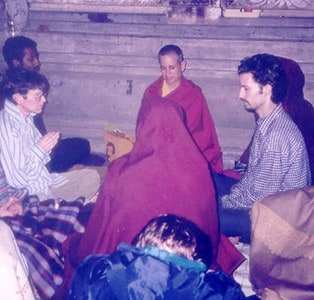Behind the scenes with Venerable Thubten Chodron

An interview conducted by Norman New in November, 2001 in Singapore, where Venerable Thubten Chodron is familiar to many Buddhists as she was a resident teacher at Amitabha Buddhist Centre from 1987-1988, and also a frequent speaker at NUS Buddhist Society.
Part 1 : From an American teacher to being a Tibetan nun
First Encounter with Buddhism
Norman New (NN): Venerable, can you tell me briefly about your first encounter with Buddhism?
Venerable Thubten Chodron (VTC): In 1973, I went to Nepal as a tourist and saw many beautiful Buddhist artifacts. I got some, not because of any good motivation, but in order to have beautiful things from a foreign country. But clearly there was some attraction there. I didn’t actually receive teachings until 1975 when I went to a course taught by Lama Yeshe and Zopa Rinpoche in California.
Attraction to Buddhism
NN: You were ordained in 1977 and you have been a nun for 25 years now. What was it that attracted you to Buddhism?
VTC: Buddhism’s worldview made sense to me. It talks about rebirth and karma, the mindstream, and the possibility for enlightenment. The Four Noble Truths explains why we’re alive and gives us a purpose and positive goals in life. The fact that the Buddha said the cause of suffering was in our mind, not something external, meant I could change my experience by transforming my mind. The Buddha explained practical methods to do this, and when I tried them, they worked.
Renunciation to be a nun
NN: What was it that made you renounce your worldly life and become a nun?
VTC: First, I wanted to dedicate my life to Buddhist study and practice. I thought that being a nun would be the best way to do this because it cleared away a lot of distracting activities and obstacles. Secondly, I wanted to become clear on my ethical discipline. Sometimes what I said and what I did didn’t match, and I knew that I needed to be more consistent in how I acted. Taking vows was a way for me to be more consistent. If I said I was going to do something in the presence of the Three Jewels (Buddha, Dharma, Sangha), then I was going to do it.
Choosing the Tibetan tradition
NN: Why, among all the Buddhist traditions, did you choose the Tibetan tradition?
VTC: I didn’t choose it. When I started, I didn’t know there were different kinds of Buddhism. I went to the course taught by Lama Yeshe and Zopa Rinpoche, and what they taught was interesting so I went back. As I continued to learn, what they said was more and more interesting to me, so I kept going. I kept returning because the Dharma helped me. I didn’t go to temples of all the different Buddhist traditions and then select the one I liked the best. All I knew was I met these teachers and what they said helped me so I kept going back. That is what I mean by, “I didn’t choose the Tibetan tradition.”
Part 2 : Buddhism now and then
Buddhism today
NN: There are so many Buddhist traditions to choose from these days. Do you think it is good for people to learn about all of them?
VTC: Depending on the individual, some people benefit from exploring different centres and meditation techniques or listening to teachings from a variety of teachers before they find what’s suitable for them. But for some people, because of their mental state, doing that becomes like spiritual consumerism. I’ll consume this tradition for a while and then try that one for a while. It’s like going to the ice-cream store and trying a new flavour each time. But then we never really settle on anything or go in depth. Being a spiritual tourist isn’t helpful if we want to progress on the path.
On the other hand, after we are stable in our practice, it can be helpful to hear teachings from other Buddhist traditions. Since all the teachings come from our Teacher, Shakyamuni Buddha, hearing them will benefit us.
Spiritual materialism
NN: As you know, spiritual materialism is on the rise. Do you think it’s better for beginners to hop around and try out different teachers and traditions before sticking to one?
VTC: If a variety of Buddhist approaches is available, people can select what suits them best. Those who need to go to many different centres before they decide can do that. But for some people like me, we start off in one tradition and stick with it. What we want to avoid is a dissatisfied mind that thinks, “Maybe I’ll find a better form of Buddhism on the next block. Or I’ll find a better teacher over here.” Then we never really practice because our mind is too consumed looking for the best product. But Dharma isn’t a consumer product.
Part 3 : Fascination of the West with Tibetan Buddhism
Buddhism as a fashion
NN: I noticed that in the West, Buddhism is like a fashion. Theravada Buddhism was in vogue for a period of time, followed by Zen, and now it is the turn of Tibetan Buddhism. There is a current fascination in the West with anything Tibetan, like the Dalai Lama. What is your view on that?
VTC: When Dharma becomes a fad, then people are simply dabbling in exotica. Spiritual practice is not about popularity or fascination with what is new or mystical. Such interest doesn’t last long and doesn’t indicate a serious change in a culture because soon people will want something else that’s new and exciting. A hundred people or a thousand people coming to listen to a talk because they think the speaker is exotic does not mean they will become Buddhists. Of course hearing a Dharma talk puts good imprints in their minds that will ripen in future lives. In addition, they hear things that could help them live their lives better now. But most people attending large public events—especially people dabbling in exotica—will not become solid Buddhist practitioners in this lifetime. However, from Dharma being publicly available like that, everyone gets accurate information on Buddhism, and in addition, some people who later become serious practitioners have the chance to meet the Dharma.
Hollywood’s obsession with the Dalai Lama
NN: His Holiness the Dalai Lama is becoming quite a cultural icon among Hollywood stars like Richard Gere and Sharon Stone. Do you think it’s a legitimate way to spread the Dharma?
A: His Holiness is not deliberately trying to become popular in Hollywood. In his mind he doesn’t care whether Hollywood stars come or not. He doesn’t care if lots of people come to Buddhist events or not. Worldly fame is not at all interesting to His Holiness. He’s a sincere Buddhist practitioner and is not trying to become an icon. As for the Hollywood stars, some, for example Richard Gere, are sincere practitioners. I have observed him listening earnestly at teachings, and he has done retreats. I’ve seen him in action, and he practices. I haven’t met the other people so I can’t comment. Those who are genuine practitioners definitely benefit from the Dharma on an individual level. If they want to use their fame to promote the Dharma, that can be helpful.
Part 4 : Buddhism and Society
Engaged Buddhism
NN: What are your views on engaged Buddhism?
VTC: I think engaged Buddhism is very important and beneficial. It’s up to each individual to choose how they practice. In other words, we shouldn’t say retreat is the ideal way for everybody, or study is the ideal way for everybody, or engaged Buddhism is the ideal way for everybody. Because people have different inclinations and dispositions, people will distribute themselves between these three things in different ways. We have to respect and appreciate that. I do prison work myself. After the attacks on September 11, our Dharma group put a full-page ad in the Seattle newspaper saying that we want a non-violent response. Right away we did something that was socially engaged.
The Middle Way
NN: It’s not easy practicing the Dharma (the Buddha’s teachings) and being engaged in society at the same time. Do you think it’s possible to strike a balance between the two?
VTC: Yes. When one is active in engaged Buddhism, it’s important to keep one’s Dharma practice very strong. Otherwise our motivation and attitudes may begin to change. We could start thinking, “My political position, my social position, or my ecological position is the one and only right way, and yours is wrong.” It’s easy to make people with other viewpoints into enemies, and that way of thinking isn’t very productive. That’s why it’s important for people who do activist work to have a solid meditation practice.
At Sravasti Abbey at Liberation Park, the monastery I am co-founding, we want to be socially engaged in a balanced way. Santikaro Bhikkhu, the other co-founder, is active in engaged Buddhism. We want to provide a place where engaged Buddhists can come and really get into their meditation practice. That will enable their motivation to continue to be one of compassion. Then, when they go out and start applying Buddhist principles to social welfare issues, they’ll do it in a healthy way.
Part 5 : Buddhism and Terrorism
Response to terrorist attack
NN: After the September 11 terrorist attack, America retaliated. Do you agree with President Bush’s stance on this? What do you think is the best solution?
VTC: No, I don’t agree with President Bush’s position. I’m not a politician, and I don’t envy his position and his responsibility. The karmic weight he carries with him is tremendous. I always favour non-violent responses because violence just creates more resentment and antagonism. On the other hand, we can’t just grin and say, “We have love and compassion so what you did is alright. It’s no problem you killed six thousand people. We forgive you.” That’s stupid. There needs to be some way in which the perpetrators are apprehended and imprisoned in order to prevent them from harming others and creating more negative karma themselves. As to the exact diplomatic, political, economic, military way to capture people rather than kill them, I am not an expert in that.
The “island mentality”
NN: Many people in Singapore are more concerned about their own rice bowls than the bombing in Afghanistan. How do you think we can change people’s mentality with regards to that?
VTC: People need to consider and to train their minds in the awareness that all sentient beings want happiness, and don’t want suffering. This doesn’t mean just our families want to be happy and not suffer or just Singaporeans want to be well and happy. Everyone does. That includes people with whom we disagree, people of different races, nationalities, and religions, and even sentient beings in other realms of existence.
Because Singapore is a very small place, an island, it’s easy for Singaporeans to have what’s called an “island mentality.” This means that as long as you are on the island, the rest of the world almost ceases to exist in your mind. Whatever isn’t on this island, is faraway. We need to broaden our mind and see that the rest of the world does exist. So many people experience suffering, even as I live my very comfortable life here. For the benefit of our planet, we must develop an awareness that people are exactly like us, wanting to be happy, wanting to be free of suffering. We need to recognize that other sentient beings have been tremendously kind to us and that our very life depends on them. When we see this truth, we will automatically want their rice bowl to be filled. We won’t be stuck in self-centeredness, thinking about just our own rice bowl. We will care about what happens to others instead of just caring about ourselves and our own family. So, these meditations on love and compassion are important.
Part 6: Buddhism in the 21st century
Relevance of Buddhism
NN: How relevant do you think Buddhism will be in the 21st century?
VTC: Very relevant, I hope. The Buddhist teachings go beyond time. Why? Because they address the human mind and how it works. Although our cultural, economical and political situations are different from those at the time of the Buddha, the basic human mind is the same, so the teachings are applicable.
Getting reborn
NN: Looking at the world at this moment in time, I really don’t know what to expect when I get reborn again.
VTC: I was thinking about that the other day. We pray for a human rebirth, and I was thinking, “Where would I pray to be reborn right now? Will I be assured of a good opportunity to practice Dharma?” It’s difficult isn’t it? Most of the traditional Buddhist societies are in upheaval, and the places where Buddhism is now spreading are also in upheaval. So it’s hard to know where we would pray to be reborn—maybe we just have to go to the pureland! There are also other human realms, or we could get enlightened in this lifetime. Sometimes I look at little kids and think, “What are their lives going to be like when they are my age? How are they going to be able to practice the Dharma? What’s the world going to be like for them?”
Setting up an abbey in America
NN: You are beginning a monastery in the USA called Sravasti Abbey at Liberation Park. What is the motive for setting up the Abbey?
VTC: In the Tibetan tradition in America, there is not one place where people who are interested in training as a monastic can go and prepare for ordination and receive proper monastic training. There are Dharma centres, but they are designed for lay practitioners, even though some monastics may live there. Those monastics work at the Dharma centres but they don’t get training on how to be a monastic. It’s crucial for the existence of Dharma in a country that there be a sangha (community of monks and nuns). As the Buddha said, “The Dharma exists in a place where the sangha community exists.” There has to be a stable sangha community in a country for Buddhism to flourish in that place, and the sangha is not firmly established in America at this point. I want to contribute towards that happening so that people can receive proper training, understand the ordination and precepts properly, and live a monastic life.


